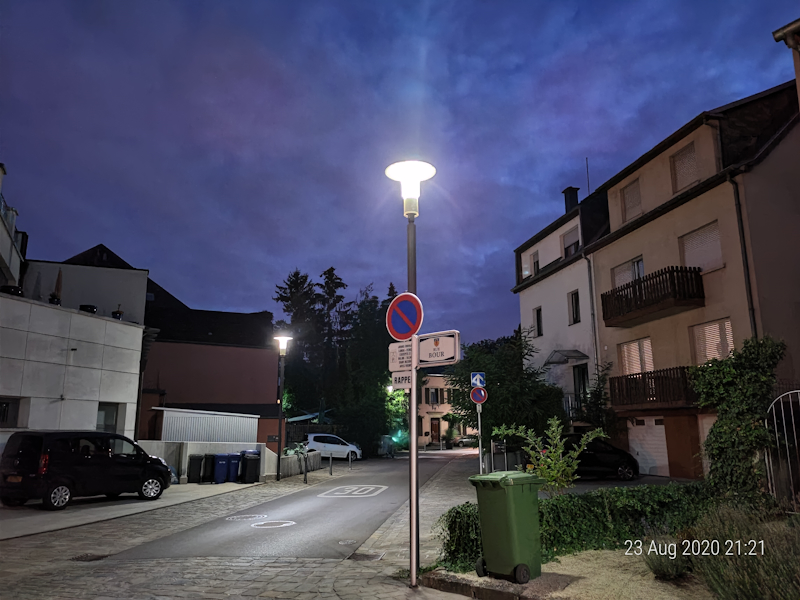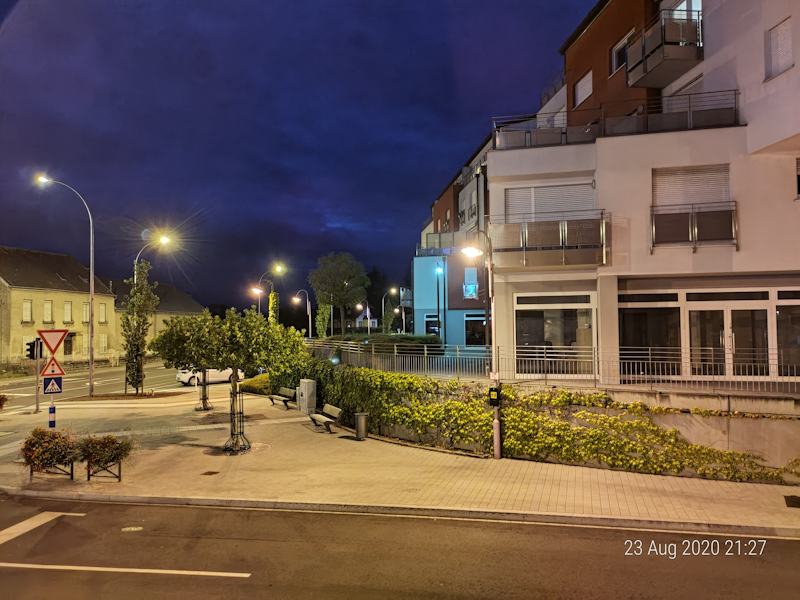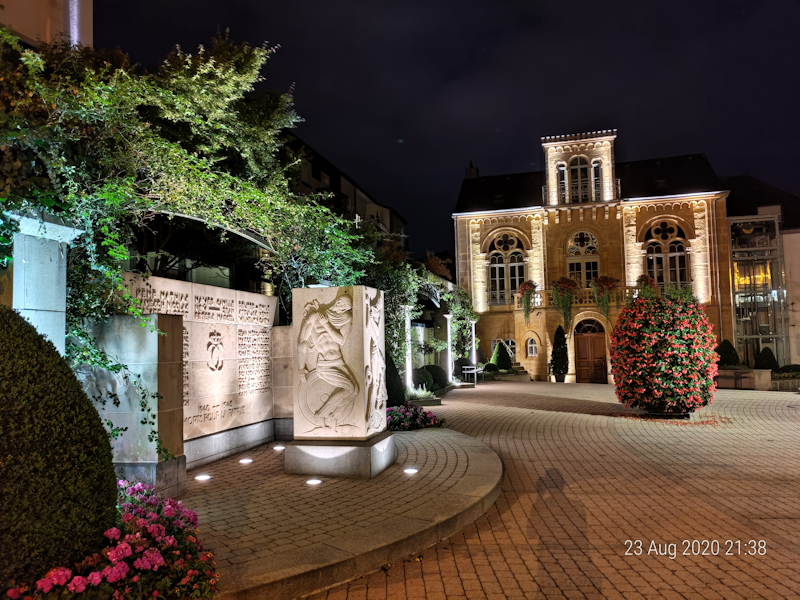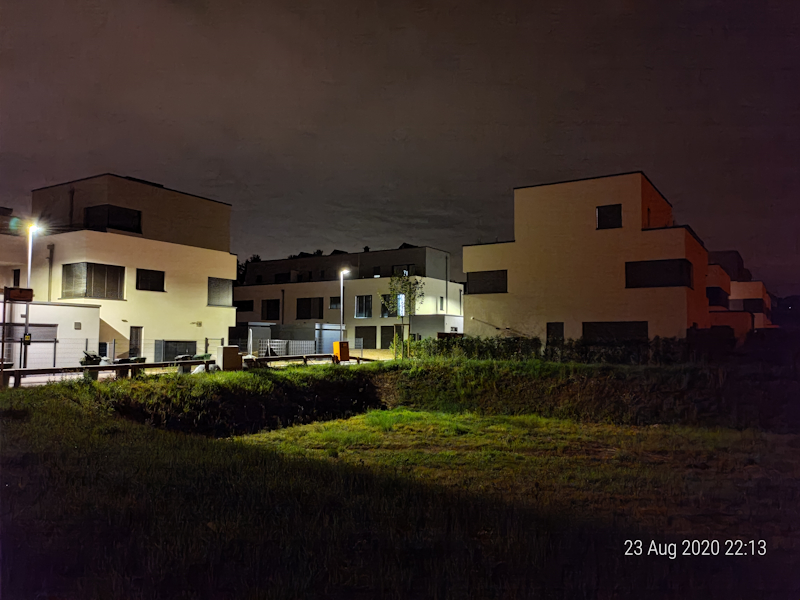The ASUS ZenFone 7 Pro Review: The Triple Flip-Camera
by Andrei Frumusanu on September 1, 2020 3:00 AM EST- Posted in
- Mobile
- Asus
- Smartphones
- ZenFone 7
- ZenFone 7 Pro
Camera - Low Light Evaluation
Low-light capture of the ZenFone 7 is actually an interesting topic as we had seen ASUS’s night mode implementation in the ROG3 perform quite well when it comes to its algorithms for computational photography, albeit being handicapped by the lack of OIS.
The ZenFone 7 Pro does have OIS so we should see quite improved low-light photography results. It’s important to keep in mind though that the results posted here are only representative of the Pro variant, as the standard base model doesn’t feature OIS, with results likely much worse than what’s presented here.

[ Zenfone 7 Pro ] - [ ROG Phone III ]
[iPhone 11 Pro ] - [Galaxy S20+(E) ]
[ Pixel 4 ] - [ X-T30 ]
The first scene is actually quite impressive as the ZenFone is able to achieve a quite excellent results that is very competitive and easily beats the shots of the iPhone 11 and the S20’s. The OIS allows the phone for a longer exposure compared to the ROG3 and to fill in more of the shadows of the scene.
The ultra-wide also benefits from night-mode and the newer sensor, however the result remains quite blurry compared to what the S20 is able to achieve.
The telephoto module in low-light isn’t very good – in this instance it didn’t even manage to focus on the subject.

[ Zenfone 7 Pro ] - [ ROG Phone III ]
[ iPhone 11 Pro ] - [ Galaxy S20+(E) ]
[ Pixel 4 ] - [ X-T30 ]
The next shot also is very much in favour of the ZenFone 7 Pro as it’s extremely comparable to the Pixel 4 picture and amongst the best results in the set.
The ultra-wide here unfortunately didn’t do well as it’s completely blurry.

[ Zenfone 7 Pro ] - [ ROG Phone III ]
[ iPhone 11 Pro ] - [ Galaxy S20+(E) ]
[ Pixel 4 ] - [ X-T30 ]
When there’s a bit more light, the ZenFone also fares extremely well and it’s again quite surprising to see just how similar the ASUS device compared to the Pixel 4. The ZenFone actually wins out in details, however both phone’s colour temperatures are wrong as the iPhone is closest to the actual colour of the sodium lamps on the street.
The telephoto module here is somewhat usable albeit it’s very noisy. Night mode doesn’t work on this module.

[ Zenfone 7 Pro ] - [ ROG Phone III ]
[ iPhone 11 Pro ] - [ Galaxy S20+(E) ]
[ Pixel 4 ] - [ X-T30 ]
The ROG3 already had done quite well in this scene before, and the ZenFone 7 Pro produces even sharper image with extremely good handling of the highlights and overall processing. I would even go as to say that it’s the best performing device amongst the comparison phones.

[ Zenfone 7 Pro ] - [ ROG Phone III ]
[ iPhone 11 Pro ] - [ Galaxy S20+(E) ]
[ Pixel 4 ] - [ X-T30 ]
Again, it’s the OIS which makes the difference to the ROG3 as in lower light conditions the ZenFone 7 Pro manages a 2.6x higher exposure through a combination of slower shutter speeds as well as a higher ISO level.
I would again as to say it’s amongst the best performers here as it manages to still retain a lot of detail, and most importantly it also got the colour temperature right.

[ Zenfone 7 Pro ] - [ ROG Phone III ]
[ iPhone 11 Pro ] - [ Galaxy S20+(E) ]
[ Pixel 4 ] - [ X-T30 ]
Further in extreme low-light, the ZenFone 7 Pro continues to impress with its superior night mode, able to retain a ton of detail and more dynamic range than other phones.
Low-Light Conclusion - A Surprise Top Contender
Overall, the ZenFone 7 Pro really surprised me in terms of its low-light capture ability. ASUS’s Night Mode showed potential on the ROG3, and the addition of OIS really augments the whole camera system to a level that’s not only competitive with other smartphones on the market, but more often than not it actually beats them when it comes to detail and exposures.
The ultra-wide isn’t as well tuned as the main camera, and here it mostly loses out to Samsung’s night mode implementation. The telephoto module is largely not usable in low-light.










31 Comments
View All Comments
GC2:CS - Tuesday, September 1, 2020 - link
I find the battery lifespan saving max charge limit comparison somewhat dishonest.For the same usage you need 500 cycles at 80 and just 400 if you charge to 100. So it is more like 7 and 12% degradation.
I think limiting charge might be usefull for things like headphones. They just sit for days in their case charged to 100%.
Also I am quite woried where we are going with battery capacities. Looks like even 4000+ mAh is not a guarantee of great battery life these days.
CampGareth - Tuesday, September 1, 2020 - link
That's assuming you drop to 0% charge every single time, under that usage you're going to burn through batteries regardless. The state of charge limit is intended more for folks that stay at a high charge percentage. I can't remember the last time my phone dropped below 60%, it's on charge at home and at work so spends a lot of time sitting at 100% charge which degrades the battery faster even when it's idle.imoc - Tuesday, September 1, 2020 - link
Not true. Their graph states SoC(State of charge) and charge cycle doesn't mean Any%-80%, a full 100% battery top up counts as one(such as 30-80 two times).close - Tuesday, September 1, 2020 - link
There are a few trends to dislike, small batteries for the consumers attached to the phone (mega SoCs, gazillion Hz screens, all of the Gs, all the time), glass backs especially when not actually needing it, removing the headphone jack even on phones that are clearly big enough to fit one, etc. This phone ticks most of them.SirDragonClaw - Tuesday, September 1, 2020 - link
You need to learn how modern batteries work...huyhung411991 - Tuesday, September 1, 2020 - link
First paragraph in Battery Life section is repeated.Ryan Smith - Tuesday, September 1, 2020 - link
Thanks!linuxgeex - Tuesday, September 1, 2020 - link
Before I even look at image quality with video recording, I pay attention to the background noise. You should be able to tap the screen, adjust volume up and down, power the screen on and off, and walk in light wind without hearing distracting sounds. This camera failed this basic requirement with flying colours lol.Kangal - Tuesday, September 1, 2020 - link
Dunno, it's hard to judge the quality without a reference.The photo, video, microphone comparisons should have something like a Sony A7 + Lav, as that's basically professional quality, and it would be much easier to spot where phone's deficiencies lay.
Bonus points should be made to compare all devices on a quick Auto Mode, but Manual-Professional Adjustment on the Mirrorless. That's the most important comparison. And do it in Good Lighting, Overcast, and Low-light conditions. And do it in Macro, Regular, and Zoom modes.
Manual Modes are interesting on the new Sony Xperia 1 ii Pro, and LG V60... but are somewhat gimmicky. Phones are meant for quick "point and shoot", for professional quality you can't subsidise a phone with manual mode for a proper DSLR or Mirrorless. It would be like trying to use a hot-hatch to move heavy loads, then complaining, instead of using a pickup truck.
linuxgeex - Tuesday, September 1, 2020 - link
@Andrei - several of the camera comparison photos are missing and some are backwards.